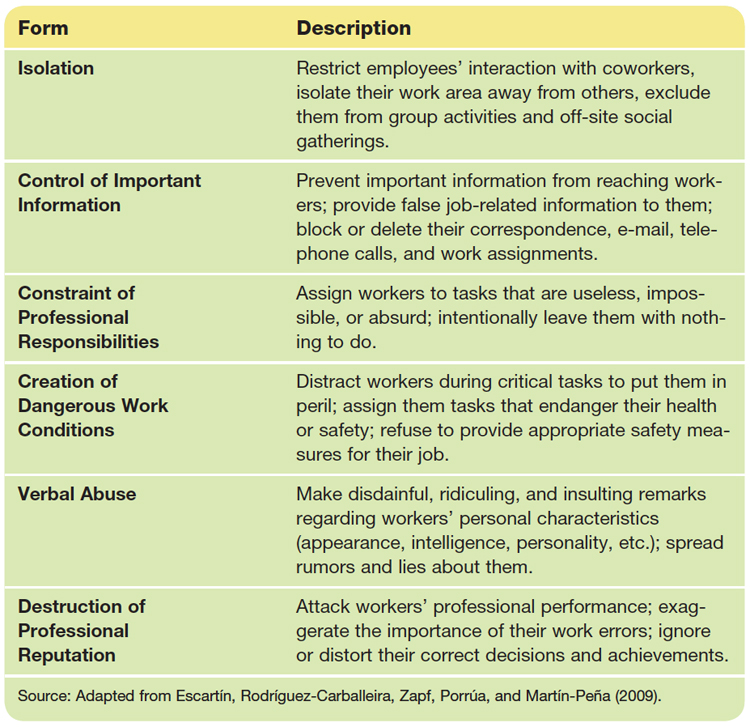12.4.1 Workplace Bullying
Printed Page 407
Workplace Bullying
In the course of your professional lives, many of you will experience situations similar to what I went through with Rob, my trucking boss. Workplace bullying is the repeated unethical and unfavorable treatment of one or more persons by others in the workplace (Boddy, 2011). Bullying occurs in a variety of ways, including shouting, swearing, spreading vicious rumors, destroying the target’s property or work, and excessive criticism. It is also perpetrated through “passive” means, such as the “silent treatment,” exclusion from meetings and gatherings, and ignoring of requests (Tracy, Lutgen-Sandvik, & Alberts, 2006). In nearly one-fifth of cases, workplace bullying involves physical violence, including hitting, slapping, and shoving (Martin & LaVan, 2010). When bullying occurs online, it is known as cyberbullying. The most frequently reported forms of workplace cyberbullying are withholding or deleting important information sent via e-mail and spreading gossip or rumors through text messages, e-mails, and online posts (Privitera & Campbell, 2009). Perpetrators of workplace bullying usually combine several of these tactics to intimidate their victims. The most common forms are detailed in Table 12.2 below.
Table 12.2 Common Forms of Workplace Bullying

Workplace bullying has devastating effects on the targets’ physical and psychological health. Bullying typically generates feelings of helplessness, anger, and despair. It can even cause health problems such as sleep disorders, depression, and chronic fatigue (Tracy et al., 2006). Plus, the associated costs to companies are huge and include disability and workers’ compensation claims, lawsuits, low-quality work, reduced productivity, high staff turnover, increased absenteeism, and deteriorated customer relationships (Tracy et al., 2006).
Unfortunately, workplace bullying is common: 25 percent to 30 percent of U.S. employees are bullied at some point during their work lives—10 percent at any given time (Keashly & Neuman, 2005). In one-third of cases, the bullying occurs despite existence of official antibullying workplace policies (Martin & LaVan, 2010). One reason that bullying is so widespread is that when bullied workers share their stories of abuse with others, they typically aren’t believed (Tracy et al., 2006). The types of abuse that occur are often so outrageous that people simply can’t accept them as true. Adding to this, workplace bullies typically put on an act for their supervisors: behaving in a supportive fashion while they are watched and then being abusive when the boss is not around (Tracy et al., 2006). Workplace bullies can be such good actors that even trial juries believe them. In 73 percent of legal cases in which bullied employees took bullying supervisors to court, juries found in favor of the supervisors (Martin & LaVan, 2010).

How can you cope with workplace bullying? Some people simply quit and find another job (Bies & Tripp, 1998). Of course, this is not an option for everyone, since most people are dependent upon their income and new job opportunities can be limited. Others give in to the bullying, choosing to ignore it or tough it out because the perceived costs of challenging the abusive supervisor are too high. For example, if you take your complaints to your supervisor’s boss, that person may side with your supervisor—leading to an escalation in the bullying. Another option is to use your interpersonal communication skills and directly confront the bully (Bies & Tripp, 1998). In private, point out which actions you feel are abusive and ask the bully to stop. Some bullies may back off when they are confronted. At least one study of workplace bullying found that, although the most frequently reported strategy for dealing with workplace bullies was avoiding or ignoring them, the respondents who confronted their abusers reported improvements in their subsequent interactions (Keashly et al., 1994).
Workplace Bullying
- Responding more effectively to workplace bullying
-
 Consider the situation, and yourself, from the bully’s perspective.
Consider the situation, and yourself, from the bully’s perspective. -
 List the bully’s behaviors and possible motivations for them.
List the bully’s behaviors and possible motivations for them. -
 Plan your responses. For each behavior, what would you say or do? Factor in the bully’s motivations.
Plan your responses. For each behavior, what would you say or do? Factor in the bully’s motivations. -
 Assess the effectiveness of your responses. Would your responses likely generate positive or negative outcomes? What are the organizational repercussions of your responses?
Assess the effectiveness of your responses. Would your responses likely generate positive or negative outcomes? What are the organizational repercussions of your responses? -
 Use your planned responses the next time the bully behaves badly.
Use your planned responses the next time the bully behaves badly.